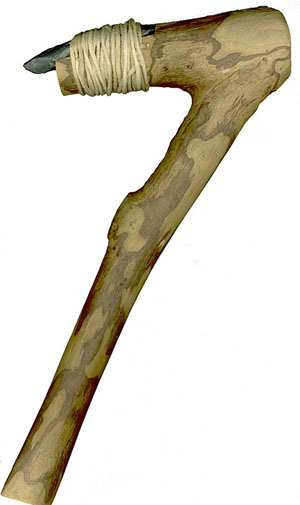Woodworking Tool Tradition
We archeologists cannot seem to agree on whether to call them adzes, gouges, distally beveled tools, or just plain tools, but these distinctive chipped-stone artifacts represent a long-lived tradition of making woodworking tools in the South Texas Plains and they are found almost everywhere in the region. Not only are they geographically widespread, but various forms of these artifacts were used throughout most of the prehistoric era, from before 10,000 years ago onward. We prefer to call them “adzes” and “gouges,” as both are functional terms that echo how we believe these tools were used.
First and foremost they were woodworking tools, although some of them were used on scraping and shaping bone, hides, and plants from time to time. This tool class is yet another example of the Swiss-army-knife-like versatility of many of the stone tool forms used in the region (see Recycling). In the South Texas Plains, necessity was the mother of adaptive tool use, we might say. But let’s stick with the main function—woodworking—because that is the most common and consistent kind of use wear evidence documented by several careful microscopic studies of these tools. Why, you might wonder, were woodworking tools so common in a region that is not known for its forests of towering trees? We’ll come back to this very good question after describing these tools and adding some technical detail.
Adzes and gouges are relatively chunky stone tools that have a beveled (steep-angled) working end (bit) as a common element and most of them are wider at the working (distal) end than the opposite (proximal) end, which is always rounded or blunt pointed. Whether they have rounded or pointed proximal ends, and convex, straight, or concave working edges, they all are characterized by distally beveled working edges that form an angle ranging from 45-85 degrees. Most were bifacially made, but some, especially early forms were unifacial and made on large flakes in such a way that they have a flat (ventral) face and a humped and flaked (dorsal) face. And then there is the rather peculiar Guadalupe tool, which is sometimes said to be “trifacial,” meaning that it almost has three flaked surfaces forming a subtriangular cross-section. But they all have steeply beveled working ends and almost all of them are chunky (relatively thick) compared to projectile points and knives. Many appear to have been hafted, that is they were affixed to wooden handles, but probably in several different ways, and others were probably hand-held tools. These differences have interesting functional implications that are discussed below.
And there are lots of them. As a group, they are probably the most common tool class found in the South Texas Plains except for projectile points and simple unmodified flake tools. Adze and gouge forms include the following named types: Clear Fork, Guadalupe, Nueces, Dimmit, and Olmos. Of these, the last three are unique to the region and the distribution of the Guadalupe tool extends only just beyond the region. In contrast, Clear Fork tools occur far to the north across the Edwards Plateau and into the Southern Plains. The Clear Fork category is also the most problematic because the style name has been applied to a considerable range of tools of varying size, form, and age.
Within the region, the Clear Fork name is applied to the earliest and largest gouges/adzes. Large bifacial Clear Fork tools have been found at some Paleoindian sites. These artifacts first appear by end of the Late Paleoindia era about 10,000 years ago, and probably considerably earlier. Large unifacial Clear Fork tools are common in Early Archaic sites. But smaller unifacial and bifacial adzes and gouges that have been called Clear Fork tools occur in later Archaic contexts. Dale Hudler’s thorough use-wear study of Clear Fork tools from southern and central Texas concluded that although many were woodworking tools, some were also used on bone or antler, hide, and soft vegetal material. Some individual tools were found to have two different kinds of use polish “bolstering the image of a formal tool that was sometimes used for a variety of tasks.”
Guadalupe tools date only to the Early Archaic and they have a most peculiar look, being very thick at the working end and having a flat, almost circular bit formed most often by very steep flat-faced bevel. They occur mainly in the northern part of the South Texas Plains from along the Balcones Escarpment, west to the Rio Grande and east to just past the Guadalupe River; the area of highest density is the greater Guadalupe drainage basin (including its largest tributary, the San Antonio River). This form has been well studied by Kenneth Brown and others and is clearly a woodworking tool used as an adze (see below). Interestingly, several caches of Guadalupe adzes have been documented that appear to be groups of functional tools stored for future use that were never reclaimed.
Nueces and Dimmit tools were originally defined as scrapers, but use-wear on many specimens examined under magnification also suggests that they were employed as woodworking adzes and gouges. The macroscopic and microscopic use-wear on Olmos tools, the smallest and latest of the lot, also appears consistent with their use as woodworking tools. Materials of various hardnesses (i.e., soft and hard woods, hides) appear to have been worked with all three of the tool forms. The Nueces and Dimmit tools have unifacial and bifacial variants while the Olmos tools are strictly bifacial. Overall then, although Nueces, Dimmit and Olmos tools represent multi-purpose tools used on various kinds of raw materials, woodworking is the dominate pattern.
“Adze” versus “gouge,” is there a real distinction? As we see it, an adze has its working end (the head of the tool) installed perpendicular or nearly so to the handle of the tool. The alignment of the working edge also cross-cuts the alignment of the handle (i.e., it is perpendicular to the handle) rather than paralleling it as in a hatchet or axe. It is used in a downward chopping motion such that the bit glances against the material being worked. Adzes require two tool head design features: (1) a longitudinal curve so that the back (dorsal face) of the adze is curved, and (2) a bevel working edge that deflects the shavings away from the material being worked. All adzes, modern and ancient, seem to have these two characteristics.
Modern woodworking adzes made of metal vary in size and shape, depending on the final product being desired. Some have a curved working edge (a “stich” or “sweep”) that reflects the degree of curvature of the shaving being removed. A stich 3 adze has a barely curved working edge while a stich 9 has a working edge that curves an entire 180 degrees, similar to Guadalupe adzes, for instance. This type of curvature is different from the convex or straight working edge shape that many stone adzes have. Concave working edges are not functional in an adze and may explain why many of the discarded Dimmit/Nueces tools have concave working edges (i.e., they are rejected tool-making failures).
Thus, we would consider all of the triangular adze/gouge tools in the region with curving longitudinal cross-sections, and beveled edges that are on the inside of the curve as adzes. Dimmit and Nueces tools are good examples as may be some “Clear Fork” tools (more on these in a bit).
In contrast, we perceive gouges as the prehistoric equivalent to modern-day chisels, albeit most were probably not used in conjunction with a hammer. If hafted, the working blade would have been hafted in-line with the handle and the motion of use parallels the longitudinal alignment of the handle. A longitudinally curved working element (i.e., the bit of the stone tool) is not a functional necessity; instead it is preferred that the working edge be flat or reasonably so to increase tool efficiency. The steep bevel on the tool edge may still be present but is not necessary. Many Clear Fork tools may have been used as gouges, especially the unifacial examples, as well as unifacial Dimmitt “scrapers.” Many “gouges” were probably used as hand-held tools.
With the exception of the Guadalupe tool, the various other named (and unnamed variants) adzes and gouges are in need of a great deal more study before we can make further progress in sorting out variation, age, and exact function. Everyone who studies these strange tools acknowledges this need. Microscope examination of archeological specimens needs to be coupled with extensive experimental replication. The work that is needed to really understand the adzes and gouges of the region will be time consuming and require considerable expertise. Many beginning students of archeology have carried out initial studies and written papers on these tools, but only the most serious and knowledgeable studies by experienced researchers have been able to add much that is new and well documented.
Let’s return to the $64,000 question, why were woodworking tools so common in a region that is not known for its forests of towering trees? Given the range in form, size, age, and geographical occurrence, there may not be a single plausible answer beyond the obvious – the native peoples of the region made many tools out of wood and they shaped pieces of wood for building their simple dwellings. Along the Guadalupe River they may have also made dugout canoes, although no direct evidence of such watercraft has been found.
Today the South Texas Plains may be dominated by brush and the first Europeans encountered widespread grassy savannahs in some areas, but trees were always there and they were quite plentiful and big in certain places. Prior to the arrival of metal-axe- and bulldozer-welding peoples, the native valleys of all the region’s major rivers and their main tributaries all held considerable woodlands with plenty of large trees of various species. So there was no shortage of wood in all but the thickest grasslands and the upland areas with very shallow soils (which did have plenty of woody shrubs).
Still, the prevalence of woodworking tools in the South Texas Plains is a fascinating tradition. And, to judge from the great many adzes and gouges at sites spanning at least 10,000 years, a tradition that seems to have been more pronounced here than any other region of Texas. Perhaps tomorrow’s inquiring minds will learn more about why, when, and how woodworking took hold.
Contributed by Steve Black and Steve Tomka.
Sources
Black, Stephen L. and C. Lynn Highley
1985 “Distally Beveled Tools,” pp. 136-155, in Black and A. J. McGraw, The Panther Springs Creek
Site: Cultural Change and Continuity Within the Upper Salado Creek Watershed, South-Central Texas.
Archaeological Survey Report No. 100. Center for Archaeological Research, University of Texas at San
Antonio.
Brown, Kenneth M.
1985 Three Caches of Guadalupe Tools from South Texas. Bulletin of the Texas Archeological Society56:75-125.
1989 The Bingaman Cache of Stone Tools from Webb County. La Tierra 16(3):8-28.
![]() (Download article Brown-1989)
(Download article Brown-1989)
Howard, Calvin D.
1973 A Study of the Clear Fork Gouge. Bulletin of the Texas Archeological Society 44:51-60.
Hudler, Dale B.
1997 Determining Clear Fork Tool Function Through Use-Wear Analysis: A Discussion of Use-Wear Methods and
Clear Fork Tools. Special Studies in Archeology 25, Texas Archeological Research Laboratory, University of
Texas at Austin.
Steve A. Tomka
2002 “Projectile Points and Beveled Tools, an Assessment of Typology and Function.” Chapter 9, pp.
71-132, in: Mahoney, Richard B., Raymond P. Mauldin, and Steve A. Tomka, Archeological Data Recovery
Excavations along Becerra Creek (41WB556), Webb County, Texas. Center for Archaeological Research,
Archaeological Survey Report, No. 321. University of Texas at San Antonio.
 (Download Chapter Tomka 2002)
(Download Chapter Tomka 2002)
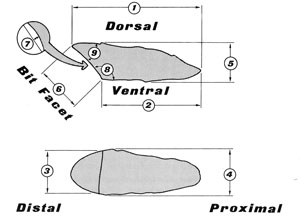
Adze terminology, from Guadalupe tool study. Brown 1985, Figure 3.
|
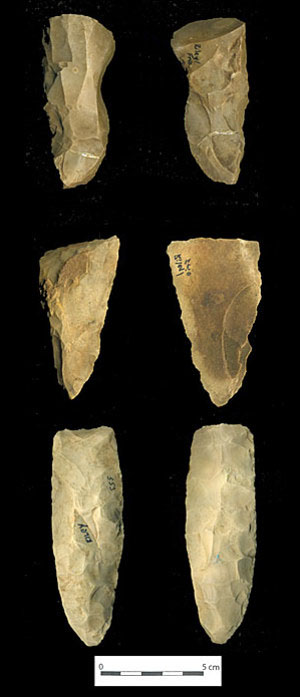
Guadalupe and Clear Fork tools. Top to bottom: Guadalupe adzes, unifacial Clear Fork gouges, and bifacial Clear Fork adzes. All are shown in two views, with the beveled working ends (bits) pointing up, dorsal views on the left, and ventral views on the right. Frio County, Riley Collection, TARL. |
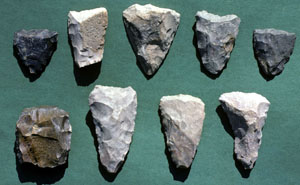
Gouge and adze forms from Choke Canyon. Photo by Grant Hall.
|
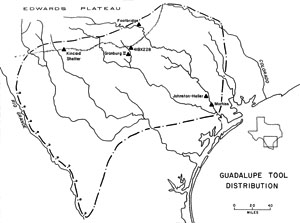
Geographical range of the Guadalupe adze. The
shaded area shows main concentration within the Guadalupe and San Antonio river basins. Adapted from
Black and Highley 1985, Figure 29.
|
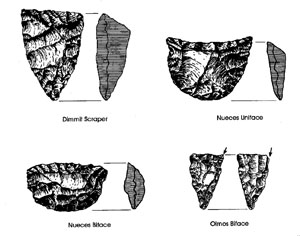
"Distally beveled" tool forms common in South Teaxs sites. Adapted from Turner and
Hester 1993.
|
